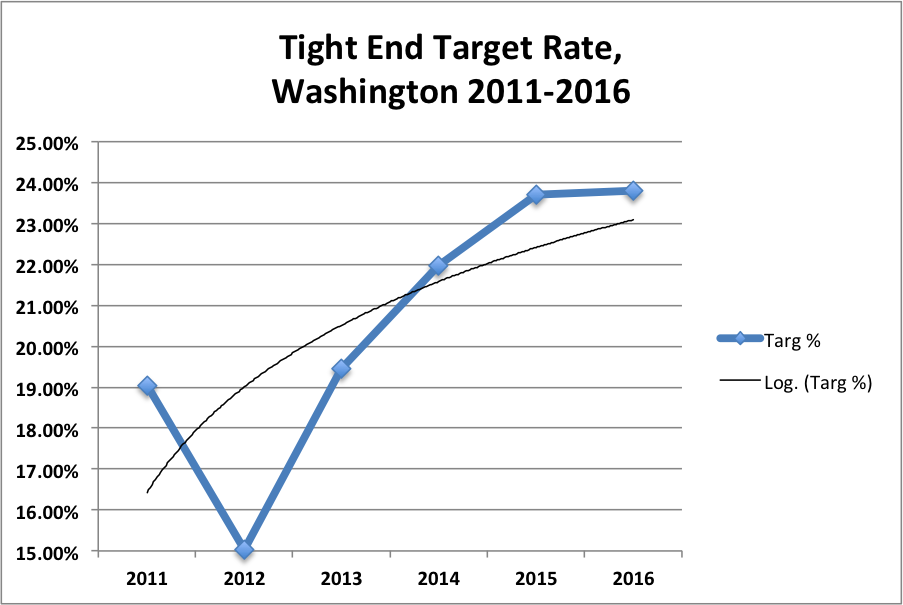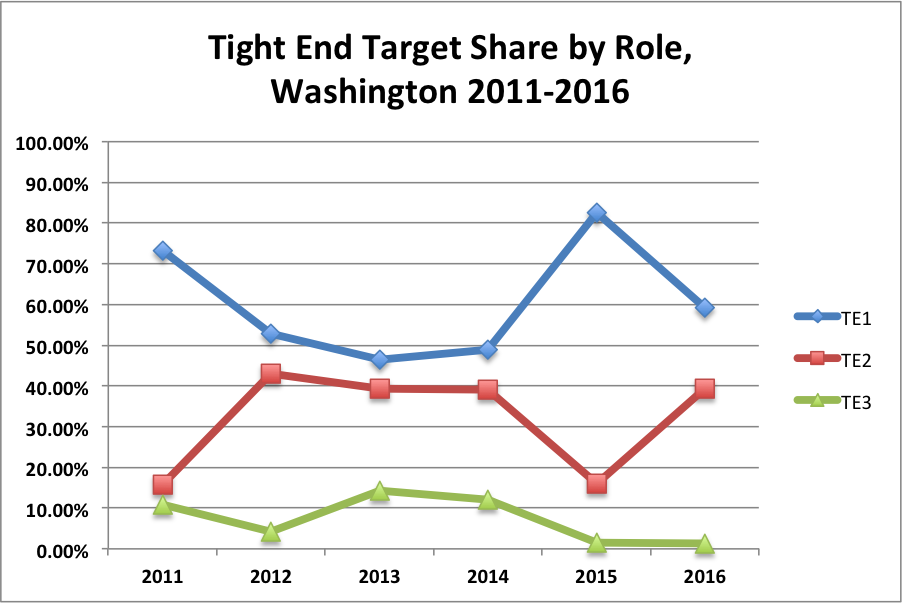Gerald Everett Adds Another Dimension to the Rams’ Offense

There are a few pieces of pop culture that truly capture the spirit of the era during which they were created.
The 2000’s were the iPod era, 1990’s had grunge music (or the Macarena, depending on who you ask), and the 1970’s were definitely the time of Saturday Night Fever.
But the 1980’s were captured best by Bill & Ted’s Excellent Adventure, a goofy cult hit film about two space-case high schoolers who travel through time, because (of course) the fate of the universe depended on them acing history class. The movie reminded us that having someone by your side to help you is one of the most important things in the world, and its B-list 1980’s metal soundtrack reinforced that – including its final jam: “Two Heads Are Better Than One†by Power Tool.
That sentiment is clearly what the Los Angeles Rams were aiming for in their new offensive approach when they drafted tight end Gerald Everett in the second round, just one season after they spent a fourth rounder on Tyler Higbee. This is an offense fully in transition, also having overhauled its offensive line and wide receiver corps, but first-year head coach Sean McVay’s history with his previous team, the Washington Redskins, indicates that the Rams are poised to feature the tight end in 2017.
How will featuring two tight ends affect their offense?
The McVay Offense: Not-So-Wild Stallions
The two-tight end set (also known as 12 personnel) really boomed around 2013, when teams across the NFL realized how good the New England Patriots’ monster packages featuring Rob Gronkowski and Aaron Hernandez were. As the Pats began to emulate this strategy, the usage of tight ends exploded -- and so did the number of teams doubling up on the position.
According to a Pro Football Focus (PFF) article from 2013, the league-average use of the two-tight end set was just under 20 percent of plays called. One of the 12 teams to top that rate in '13 was Washington, who utilized the 12 set on 22.8 percent of their offensive snaps.
And who was Washington's tight end coach that season? Sean McVay.
When McVay was promoted to offensive coordinator in 2014, the Redskins began to feed more and more looks to their tight ends. Both Washington’s total targets and the percent of drop backs converted into tight end targets spiked that year, and have only risen since then; Washington has averaged around 23 percent of their drop backs targeting a tight end during McVay’s tenure.

With so many more targets going to tight ends -- who usually work in the short area near the line of scrimmage -- we would expect the passing average Depth of Targets (aDOT) overall to get shorter, and, sure enough, under McVay, Washington quarterbacks’ average target depth went from 8.95 yards beyond the line in 2011 to 2013 to 8.51 the last three years (per PFF). Shorter targets also meant, however, that Washington quarterbacks' completion rate went up; in fact, it jumped from 60.3 percent to 67.8 percent in that time.
Also, 2016 showed a huge spike in average Depth of Target for Washington’s Kirk Cousins, due to the effective play downfield of DeSean Jackson.
If McVay follows a similar pattern for designing the offense in Los Angeles, he’ll almost certainly utilize tight ends Everett and Higbee to stabilize the passing attack early on (see 2014 and 2015 in Washington), and then introduce deeper concepts as they and quarterback Jared Goff develop in the offense down the road – whether with Tavon Austin as the deep-ball maven, or even 2017 rookie Josh Reynolds.
Utilizing extra tight ends should be a booster for the offense under Goff. Now, how does this feature role look when we project it between the Rams’ tight ends?
The Tight Ends: Be Excellent to Each Other
McVay’s offenses have featured the tight end in their game planning, but how does their production break down by roles? The chart below shows the progression of Washington tight end roles by their percent of team tight end targets from 2011 to 2016.

It’s important to note that 2015 was the only season under McVay in which Washington tight end Jordan Reed was healthy for 14 games, so it’s entirely possible that the 80/20 split between the TE1 and TE2 role that year is the ideal in this offensive scheme. We can also see there's a very small target role for the TE3 in this offense, but that really only spiked to significance in years where Reed was severely injured; the third tight end is a blocking role for McVay.
But between the two top tight end spots, what is the usage like?
We can see how much value each of them creates through numberFire’s Net Expected Points (NEP) analytic. NEP is an analytic that describes the contribution a play (or player) makes to their team’s chances of scoring. By adding down-and-distance value to the box score, we can see just how much each play and each team as a whole influence the outcome of games. For more info on NEP, check out our glossary.
The table below compares the Reception NEP per target values each tight end role generates on average in Sean McVay’s offense.
| Role | Rec | Targets | Target % | Rec NEP/Targ | Rec NEP/Rec | Rec Success % |
|---|---|---|---|---|---|---|
| TE1 | 68 | 89 | 63.7% | 0.60 | 0.80 | 80.3% |
| TE2 | 33 | 44 | 31.6% | 0.68 | 0.90 | 82.0% |
| TE3 | 5 | 7 | 4.8% | 0.10 | 0.13 | 53.3% |
On average, the top two tight end roles have about a 2-to-1 target share split, indicating a slightly more favorable fantasy outlook for the top tight end.
However, as illustrated by Vernon Davis’ usage in Washington last year, the second tight end role is used a bit more as a downfield receiver and seam-buster than the top role – which is a more possession-based option. A slightly higher Reception NEP per reception rate (more value per catch) and Reception Success Rate (the percent of catches that generate positive value) help illustrate for us that the second tight end in the McVay offense is a bit more of an athletic receiving mismatch than their number-one counterpart.
The table below compares Higbee and Everett to Reed and Davis in those top two roles, based on NFL Combine measurables (those marked with an * are projected based on height and weight comparables).
| Player | Team/Role | Height | Weight | 40 | Vert | Broad | Shuttle | 3-Cone |
|---|---|---|---|---|---|---|---|---|
| Jordan Reed | WAS TE1 | 6' 2" | 236 | 4.72 | 32"* | 9' 9"* | 4.30* | 7.10* |
| Tyler Higbee | LAR TE1 | 6' 5" | 249 | 4.77 | 33"* | 9' 7"* | 4.38* | 7.14* |
| Vernon Davis | WAS TE2 | 6' 3" | 254 | 4.40 | 42" | 10' 8" | 4.17 | 7.00 |
| Gerald Everett | LAR TE2 | 6' 3" | 239 | 4.60 | 37 1/2" | 10' 5" | 4.33 | 6.99 |
It’s interesting that Higbee has a frame much more like Vernon Davis', but athleticism like Reed, while Everett is the exact opposite.
It remains to be seen exactly how Sean McVay uses these two potent threats, but the sophomore “veteran†Tyler Higbee could be in line for a Jordan Reed-like workload, with a healthy dose of the speedier Gerald Everett cracking the deep middle open for Jared Goff.
Whichever of them becomes McVay’s new Jordan Reed, this offense will build its foundation on these two young tight ends. And that’s certainly better than one.
















